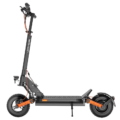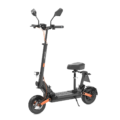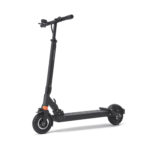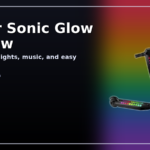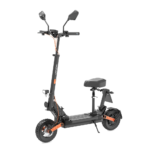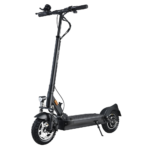- Home
- Scooters
- Electric Scooters
- JOYOR T6
JOYOR T6
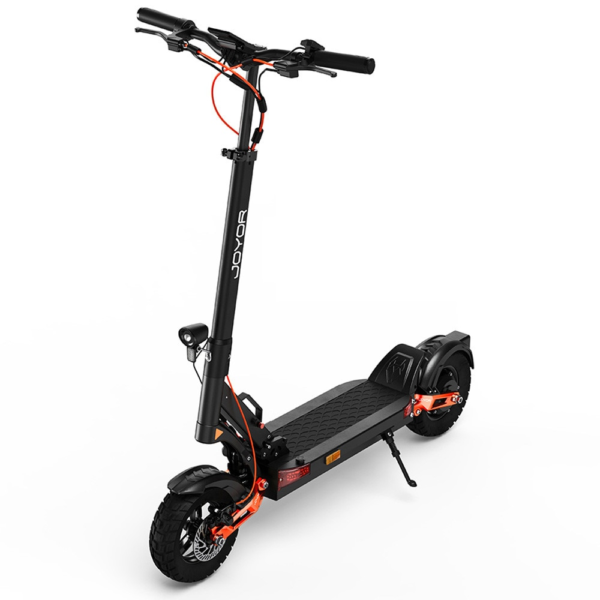

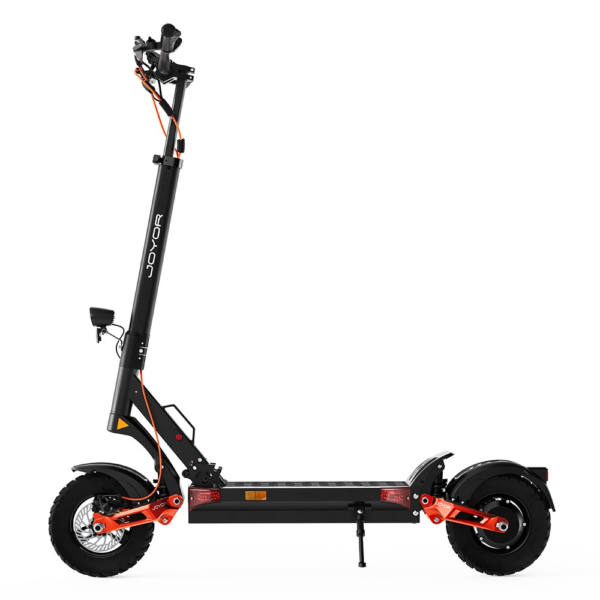
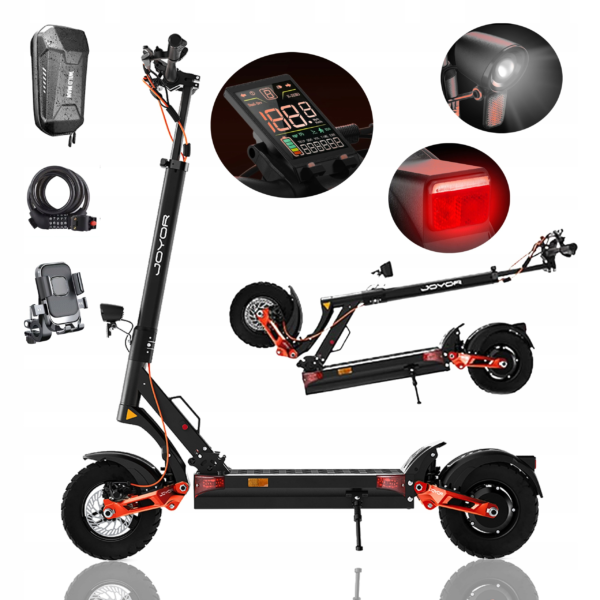
- Battery Range: 31–37 mi (50–60 km)
- Top Speed: 21–25 mph (34–40 km/h)
- Motor Power: 600 W nominal
- Weight Capacity: 242 lb (110 kg)
- Charging Time: ~7–8 h
- Scooter Weight: 44.1 lb (20.0 kg)
PROS
- Balanced power-to-weight
- Good range for daily rides
- Predictable braking
- Fast fold; compact storage
- Bright commuter lighting
CONS
- Not as light as F-series
- Pneumatics need routine checks
- Top speed may be capped legally
- Deck space average for big shoes

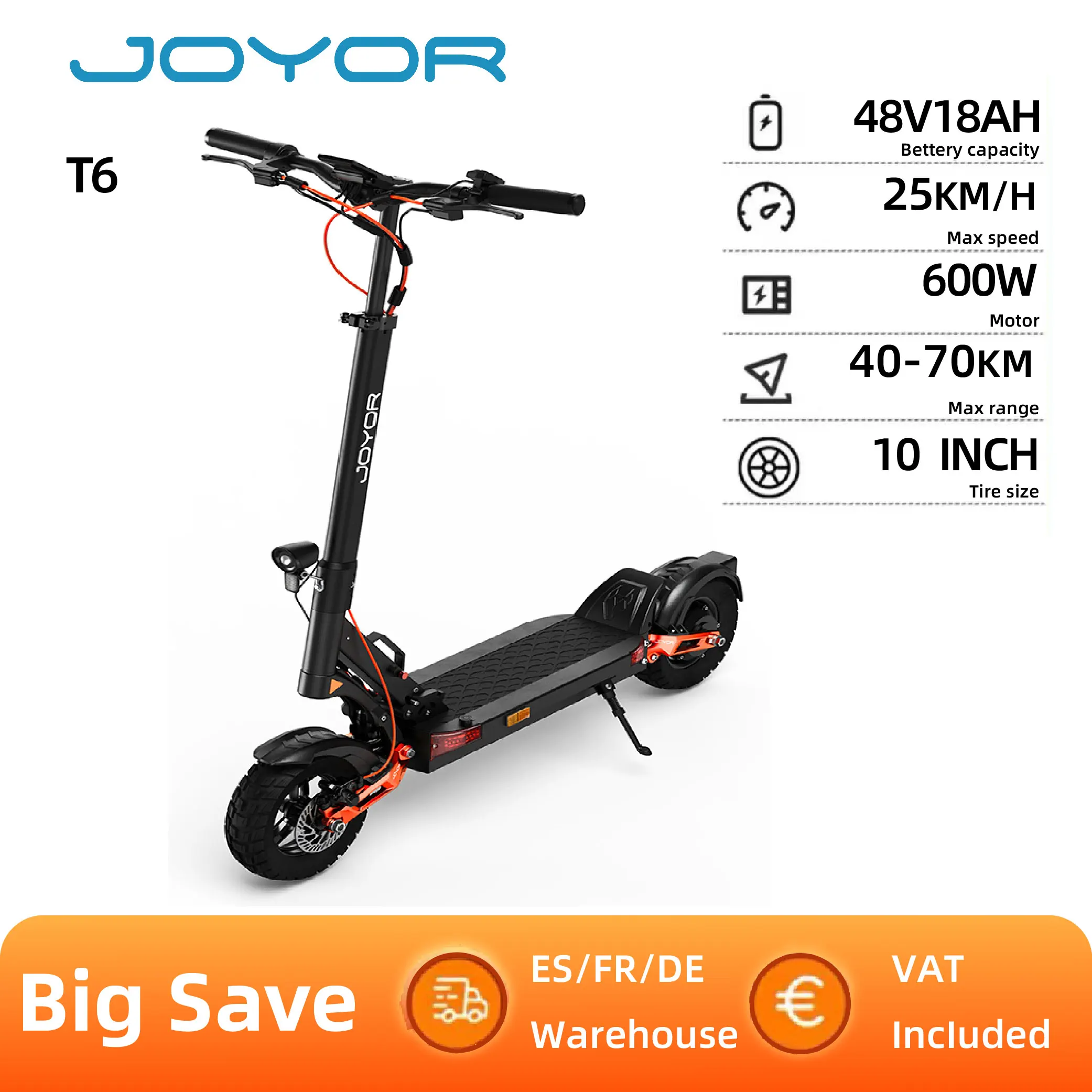

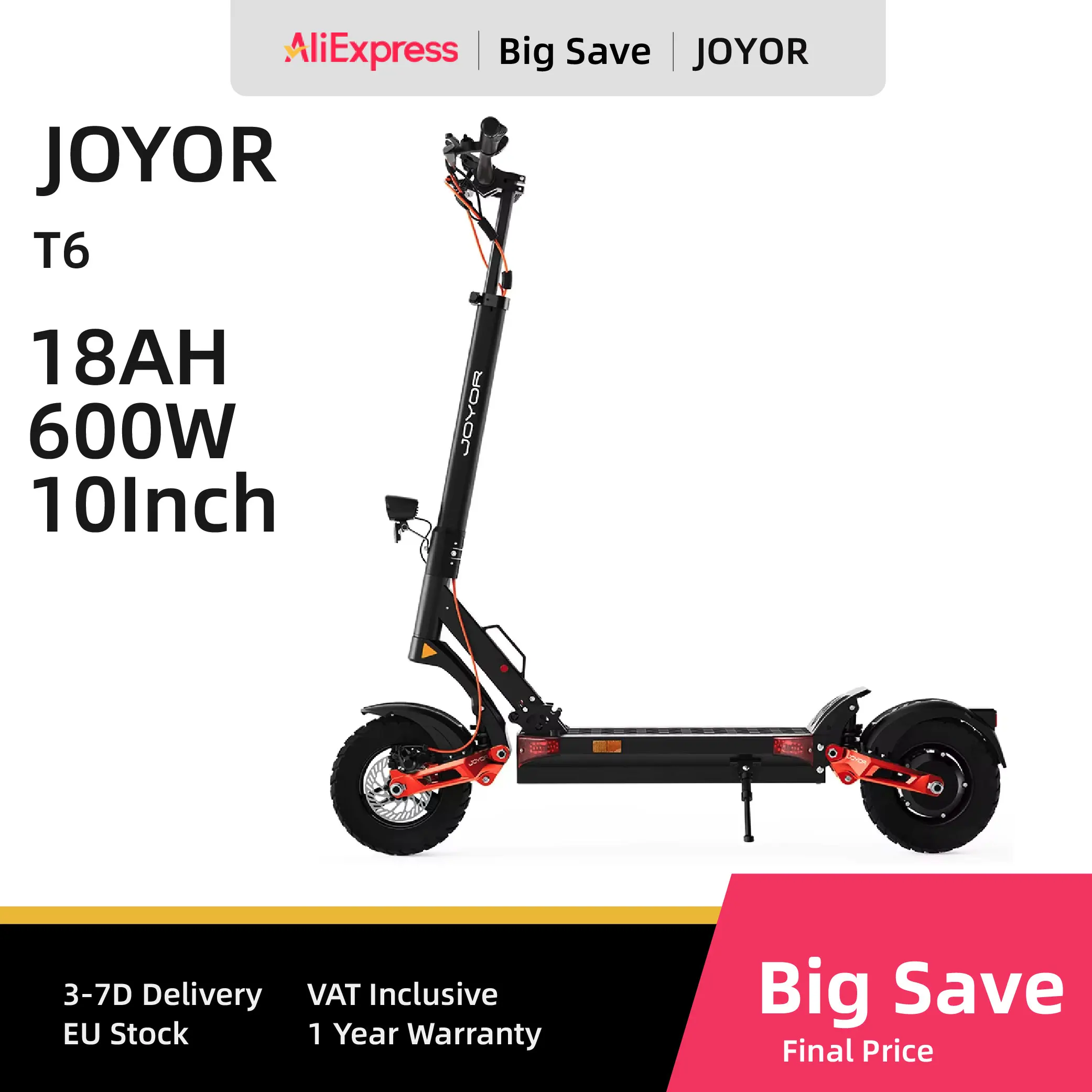

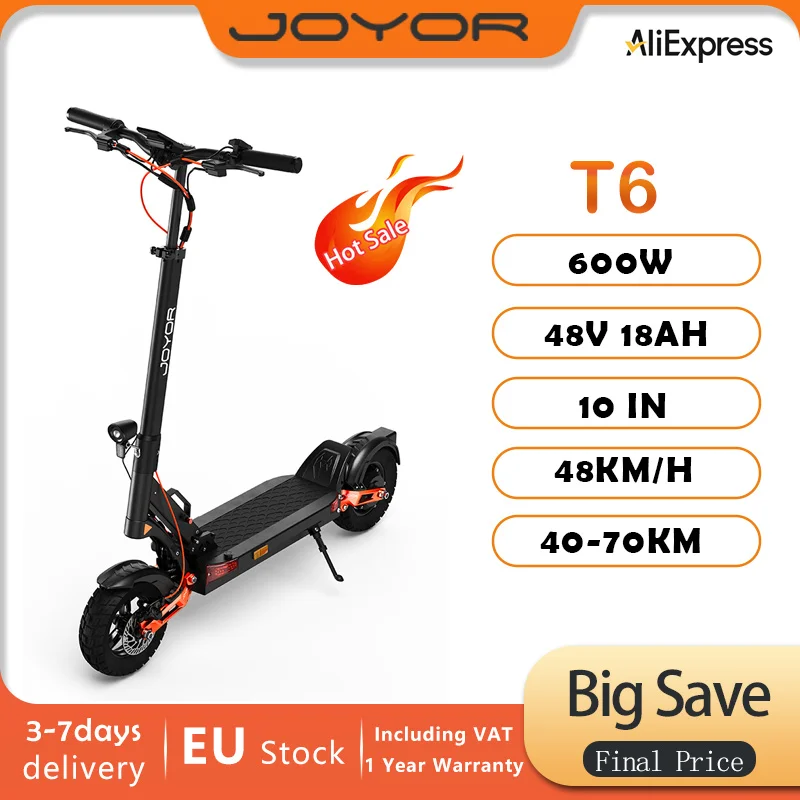
Table of contents
- What Is the JOYOR T6?
- How the JOYOR T6 Works
- Key Specifications
- Design & Build Quality
- Performance Fundamentals
- Battery, Range & Efficiency
- Ride Quality & Comfort
- Braking & Safety Features
- Portability & Daily Usability
- Maintenance & Care
- Weather & Seasonal Considerations
- JOYOR T6 vs Alternatives
- Who the JOYOR T6 Is (and Isn’t) For
- FAQs
- Glossary
- Final Thoughts
The JOYOR T6 is a sturdy, confidence-building electric scooter designed for riders who want real-world practicality with a dash of adventure. It favors sure-footed stability, long-legged comfort, and simple controls over flashy gimmicks. Consequently, it suits new and intermediate riders who want a dependable daily companion that can also explore light trails or rougher city edges.
Because it balances power, range, and durability, the JOYOR T6 fits commuters, students, and weekend explorers alike. It feels planted, absorbs bumps well, and keeps controls straightforward. Therefore, you can focus on the ride rather than fiddling with settings.
What Is the JOYOR T6?
At its core, the JOYOR T6 is an adult-sized, single-motor electric scooter built for mixed terrain. It typically pairs a robust frame with large pneumatic tires and multi-stage suspension. Consequently, it feels composed on broken pavement, cobblestone, or packed dirt paths. The deck is spacious, the stem is reinforced, and the fold is quick enough for daily storage.
Unlike ultra-light commuter scooters, it prioritizes ride quality and control. Yet it avoids the bulk of high-end performance machines. As a result, you get stable handling, predictable torque, and straightforward maintenance. That combination suits riders who want a comfortable, no-nonsense platform for a wide range of conditions.
How the JOYOR T6 Works
Motor. A rear hub motor drives the wheel directly. Because there are no chains or belts, the system runs quietly with little routine upkeep. Moreover, power arrives smoothly rather than with a harsh surge, which helps new riders build confidence.
Controller. The electronic controller acts like the scooter’s brain. It meters current to the motor based on throttle input and riding mode. In practice, the controller shapes how quickly the scooter responds and how it holds speed on small hills. Well-tuned settings deliver even acceleration and steady cruising; meanwhile, thermal protections keep output consistent.
Battery. A large lithium-ion battery stores energy. Meanwhile, a battery management system (BMS) monitors voltage, temperature, and current. Therefore, it protects cells during charging and discharging. Real-world range still depends on rider weight, terrain, wind, and speed; however, careful throttle use stretches every watt-hour.
Throttle. Most units use a thumb or trigger throttle with a readable display. Because the throttle is progressive, small inputs produce small changes in speed. That nuance makes low-speed maneuvering easier around pedestrians and in tight spaces. Additionally, the display’s simple layout reduces glance time.
Brakes. Mechanical disc brakes front and rear provide the main stopping power. Some setups add electronic braking when you release the throttle or lightly tap the brake lever. Consequently, the lever feel becomes predictable with firm bite once pads contact the rotor. As pads bed in, consistency improves further.
Key Specifications
Below you’ll find a concise table of core specifications and features. Values may vary by production run and region, yet the structure remains consistent across typical T6 units.
| Block | Highlights |
|---|---|
| General | Adult electric scooter for mixed city and light off-road use; wide, grippy deck; reinforced folding stem; readable cockpit with speed and battery info; side kickstand. |
| Performance & Power | Rear hub motor; multiple riding modes for speed and torque; steady mid-speed cruise; manageable low-speed control; practical hill behavior on moderate grades with a running start. |
| Battery, Charging & Electrical | High-capacity lithium-ion pack with BMS; standard barrel charging port; included charger; front headlight and rear brake light; basic audible warning (bell or electronic horn). |
| Build & Dimensions | Aluminum alloy frame; large pneumatic tires with all-terrain tread; dual suspension (spring or hydraulic-assisted depending on batch); substantial overall weight; folded dimensions: trunk-friendly, stem latches down for a compact profile. |
| Safety & Control | Front and rear disc brakes; potential electronic brake assist; reflectors; bright headlight aimed for path visibility; splash resistance typical for the class; secure latch for the folding joint. |
| Features & Extras | Backlit display; cruise control on many units; adjustable suspension preload on some variants; deck hook or latch for carrying; compatible with common accessories (mirrors, straps, seat in some markets). |
| Warranty & Compliance | Limited manufacturer warranty (terms vary by region); wear parts commonly available; regional compliance marks where required; printed manual for operation and maintenance. |
Design & Build Quality
Frame and Deck. The chassis uses a durable aluminum alloy. The deck is long and wide, which lets you change foot stance during longer rides. Because the deck coating is coarse, shoes grip well in rain or dust. Additionally, the underside has basic shielding for road spray and stray gravel; as a result, the deck stays intact longer.
Stem and Folding Joint. The stem feels stout when locked. A safety catch supports the main latch, which reduces the risk of accidental fold-down. You should always check the latch after unfolding; a firm click and no free play are good signs. Most units keep flex within reasonable limits, even over patched roads. Nevertheless, a monthly bolt check helps the hinge stay tight.
Cockpit Layout. The bar area stays uncluttered: throttle and display on one side, brake levers within easy reach. Grips are firm yet forgiving. As a result, you can ride gloveless without finger fatigue. The display remains readable in daylight and offers basic data: speed, battery, mode, and trip estimates. In addition, backlighting improves dusk visibility.
Fit and Finish. Panels align cleanly, and cable routing avoids sharp bends. Fender clearances are generous enough for debris, yet tight enough to limit spray. Moreover, paint and fastener quality hold up well if you follow a simple cleaning routine. Overall, the scooter looks purposeful rather than flashy; consequently, it ages gracefully.
Performance Fundamentals
Acceleration Feel. Off the line, the scooter rolls forward smoothly. It does not jerk, which helps beginners practice throttle control. With a slight lean forward and steady input, you reach a comfortable cruise without drama. Because power arrives progressively, the front wheel tracks straight; furthermore, the rear tire maintains grip on rough patches.
Cruising Stability. At neighborhood speeds, the chassis feels planted. Large pneumatic tires dampen chatter from seams and pavers. Meanwhile, the suspension smooths bigger undulations. As a result, the scooter tracks predictably on long stretches and resists head shake when you change lanes. If the surface worsens, simply relax your shoulders and let the tires work.
Hill-Climb Behavior (7–10% Grades). On moderate hills, the motor prefers a small run-up. If you enter a 7% grade at cruise, it holds speed better than if you start from a stop mid-slope. On 10% grades, you may see speed taper; however, traction remains steady if the surface is clean. The controller manages power without harsh surges, which keeps the rear tire hooked up. Therefore, pacing and momentum matter.
Battery, Range & Efficiency
Rated vs Real-World Range. Sticker range assumes a light rider, smooth pavement, mild temperatures, and conservative speeds. Real-world outcomes vary. Heavier riders, hills, and headwinds reduce distance. Cold weather and very hot weather also trim range, though for different reasons. Consequently, treat rated figures as optimistic guidelines rather than guarantees.
Efficiency Factors. Tire pressure has a big effect. Under-inflated tires add rolling resistance and heat, which wastes energy. Over-inflated tires reduce contact patch and can hurt grip on rough surfaces. Therefore, aim for a pressure that matches your weight and route. Smooth throttle use further improves efficiency, as does anticipating stops. Additionally, keeping bearings clean prevents drag.
Charging Best Practices. After rides, let the battery rest a few minutes before charging. If you plan to store the scooter for more than a week, leave the pack around mid-charge, not full. Because the BMS guards against extremes, normal use remains straightforward. Yet good habits extend the pack’s useful life. For longevity, avoid repeated full discharges; instead, top up when convenient.
Temperature Considerations. Lithium-ion cells prefer moderate temperatures. In winter, range drops as the chemistry slows. In summer, sustained high heat accelerates wear. Accordingly, park in the shade when possible and avoid leaving a fully charged scooter in a hot car. Likewise, keep airflow around the charger to prevent heat soak.
Ride Quality & Comfort
Tire Type. Large pneumatic tires define the T6’s character. They absorb sharp hits, track over cracks, and hold a line on gravelly patches better than solids. Because the tread has some depth, the tires feel composed on hard-packed dirt and unkempt streets. Moreover, correct pressure preserves both grip and comfort.
Suspension Behavior. Dual suspension takes the edge off repeated bumps. Spring rates favor comfort while still resisting bottom-outs during curb drops at walking speeds. Moreover, rebound feels controlled enough to prevent bouncing after large hits. Consequently, you can ride longer without fatigue, and your wrists stay happier over cobbles.
Ergonomics. The deck lets you stagger your feet and adjust your stance. Handlebars sit at a comfortable height for medium to tall riders. Meanwhile, the levers require modest effort, so small hands can brake confidently. If your wrists tire, slightly rotating the bars often helps; additionally, adding soft grips can reduce buzz.
Stem Flex. The stem exhibits normal, mild flex under hard braking or rough surfaces. This give acts like a micro-suspension and reduces buzz. That said, you should check the hinge and clamp bolts monthly to keep flex within design limits. If play develops, address it promptly; otherwise, wear accelerates.
Braking & Safety Features
Brake System. Dual mechanical discs give reliable stopping power with reasonable lever travel. As pads bed in, the bite point becomes more consistent. Squeeze gently at first to load the front tire, then increase pressure as weight shifts forward. This technique shortens stops and keeps the chassis calm. Furthermore, periodic rotor cleaning preserves predictable bite.
Electronic Assist. Some controller mappings add gentle electronic braking when you roll off the throttle or tap a brake lever. That feature reduces pad wear on long descents and helps settle the scooter before a corner. However, it should not replace proper braking habits; instead, treat it as a helper.
Lighting and Visibility. A bright headlight throws a focused beam forward. The rear light brightens during braking to alert traffic. Additionally, side reflectors improve cross-traffic visibility at dusk. For night rides, consider a supplemental helmet light for better corner preview; in turn, corner entries feel calmer.
Ingress Protection. The T6 is typically splash-resistant, which covers puddles and light rain. Nevertheless, avoid deep water, heavy storms, and pressure washers. Bearings and connectors last longer if you treat water as a short, gentle encounter rather than a daily bath. After wet rides, a quick wipe prevents corrosion.
Portability & Daily Usability
Weight and Carrying. The T6 is substantial. Short lifts over stairs or curbs are manageable with proper technique. Use both hands and keep the scooter close to your body. Because the balance point sits near the folding joint, plan your grip before lifting; otherwise, you may strain your wrist.
Fold Mechanism. The stem folds down and latches to the deck area. The motion becomes second nature after a few days. Always confirm the latch and safety catch before rolling off. A quick tug test verifies a secure lock; consequently, rattles are less likely. If the latch loosens, adjust it promptly.
Storage and Transport. The folded profile fits in many trunks and under taller desks. At home, lean it against a wall with the kickstand out or use a wall hook rated for the weight. For transit, protect the display and throttle from knocks by facing them inward. In addition, secure loose items that could hit the brake levers, such as straps or locks.
Security Habits. Use a quality lock through the frame, not just a wheel. Because thieves target quick wins, layer your defenses: location choice, a visible lock, and, if possible, indoor storage. Record your serial number and keep a few photos for reference; later, that evidence helps recovery.
Maintenance & Care
Tire Pressure. Check weekly. Set pressure to suit your weight and surface. Because pneumatic tires bleed air over time, a small hand pump with a gauge is essential. Additionally, inspect the tread for cuts or embedded debris.
Brake Adjustment. Listen for rubbing and watch lever travel. If the lever pulls too far, adjust cable tension. Replace pads when they thin. Clean rotors with isopropyl alcohol, not oil-based cleaners. Consequently, bite remains consistent, and glazing is less likely.
Fasteners. Vibrations loosen bolts. Therefore, inspect stem bolts, axle nuts, brake mounts, and fenders monthly. Use thread locker where the manual recommends it. After any curb strike, recheck the folding joint. Moreover, mark critical bolts with a paint pen to spot movement.
Firmware/App Habits. If your unit supports settings, update only when needed and only from trusted sources. Read change notes before applying any update. Stability matters more than novelty on a commuter machine. If a new firmware adds features, test them in a safe area first.
Cleaning. Wipe dust and grit from the deck and hinges. Avoid soaking the scooter. A damp cloth and mild soap work well. Grease pivot points lightly if the manual allows it. As a result, squeaks and play tend to stay away. Finally, dry the scooter after rain to protect hardware.
Simple Service Schedule.
- Before each ride: Tire pressure check, quick brake lever test, latch inspection.
- Weekly: Bolt check on stem and brakes, rotor wipe, cable stretch glance.
- Monthly: Pad inspection, caliper alignment, suspension fastener check, deep clean.
- Seasonally: Tire tread review, battery health notes based on range, full fastener inspection.
Weather & Seasonal Considerations
Rain. Traction drops on paint stripes and metal covers. Brake early and stand taller to add front tire grip. Because spray reduces visibility, keep your headlight on and ride slower. Additionally, avoid sudden throttle changes; instead, roll on and off gently.
Cold. Expect range to fall when temperatures drop. Warm the pack indoors before riding when possible, and avoid fast charging in the cold. Dress your hands warmly so you can modulate levers precisely. Consequently, control stays consistent, even with numb fingers.
Heat. High heat stresses batteries and tires. Park in shade, let the scooter cool before charging, and monitor pressure since heat raises PSI. As a result, grip and comfort remain more predictable. If the deck feels hot to the touch, give it time to cool.
Wind. Headwinds cut range and can push you off line. Loosen your shoulders, bend your elbows, and keep a light, active grip. With that stance, the chassis can “float” rather than fight every gust. Crosswinds demand the same approach; moreover, avoid sudden steering inputs.
JOYOR T6 vs Alternatives
Against Lightweight Commuters. The T6 offers superior comfort, better rough-surface control, and more stable cruising. However, it weighs more and takes more space when stored. If your priority is effortless carrying, a lighter scooter may suit you better.
Against High-Performance Scooters. The T6 is easier to live with day to day. It demands less attention and feels calmer. Yet it will not match the brutal acceleration or top-end speed of dual-motor machines. On the other hand, it also avoids the cost and upkeep that come with those extremes.
Against Off-Road-Focused Models. The T6 handles light trails and city grit well. Nevertheless, purpose-built off-road scooters may have beefier suspension and knobbier tires. Those come with more weight and higher upkeep. Therefore, consider how often you truly ride off pavement.
Where the T6 Excels. Mixed-surface routes, daily reliability, comfortable pacing, and practical maintenance. If you want a resilient platform that still fits city life, it hits a sensible middle ground. Conversely, if you chase maximum speed, look elsewhere.
Related Reading. For a sportier sibling in the same family, see the JOYOR S5 Pro review.
Who the JOYOR T6 Is (and Isn’t) For
Great For
- Daily commuters who split time between smooth streets and patched roads.
- Students who want a durable scooter that still folds for storage.
- Multi-modal travelers who ride, fold, and hop on transit.
- Weekend explorers who like canal paths, park loops, and light dirt sections.
Not Ideal For
- Ultra-light fans who carry their scooter up many flights daily.
- Speed chasers who want the fastest launch and top end.
- Heavy off-road riders who need long-travel suspension and aggressive tires.
Why This Fit Matters. Matching scooter personality to route and storage needs prevents regret. Additionally, picking a calmer chassis improves confidence during the learning phase.
FAQs
1) Is the JOYOR T6 suitable for a first scooter?
Yes, if you value stability and comfort. It delivers smooth power, clear controls, and predictable brakes. Start in the gentlest mode and practice braking drills before traffic; thereafter, increase speed gradually.
2) How far can it go on a charge?
Range depends on weight, terrain, wind, temperature, and speed. Ride at a steady pace with proper tire pressure to maximize distance. Additionally, avoid frequent hard launches and deep discharges.
3) Can I ride it in the rain?
Light rain and puddle spray are generally fine. However, avoid deep water and storms. Dry the scooter after wet rides and re-lubricate any allowed pivot points. If the deck gets slick, slow down.
4) What maintenance does it need most often?
Tire pressure checks and brake adjustments. Because these jobs are simple, you can keep the scooter feeling sharp with a hand pump and basic tools. Moreover, a monthly bolt check prevents creaks.
5) How does it handle hills?
On 7–10% grades, it prefers a short run-up. It will climb from a stop, but speed may drop. Keep your weight centered and watch traction on slick surfaces. Therefore, choose a line with clean pavement.
6) Where does this “JOYOR T6 overview” fit if I already know the basics?
It gives a consolidated view of design, performance, range, comfort, safety, and care. Use it as a checklist when evaluating your ride or planning upgrades. In short, it’s a one-page reference.
7) Does it have cruise control?
Many units include cruise control. Engage it on straight, clear sections only. Disengage by touching the brake or adjusting the throttle; consequently, you remain in full control.
Glossary
Amp-hour (Ah). A measure of battery capacity. Higher Ah generally means more stored energy at the same voltage.
Watt-hour (Wh). Voltage times amp-hours. It approximates total energy. More Wh usually equals longer range when other factors match.
Controller. The electronic module that manages motor power. It interprets throttle input and sets current flow; moreover, it enforces protections.
Regen (regenerative braking). A feature that feeds some energy back to the battery when you slow down. It reduces pad wear slightly; however, it is not a substitute for discs.
Stem Flex. Small, controlled movement in the handlebar stem under load. A bit of flex can improve comfort; nevertheless, excess flex needs attention.
IP Rating. A code describing resistance to dust and water. Higher numbers usually mean better protection; even so, avoid submersion.
Pneumatic Tire. An air-filled tire that absorbs bumps and improves grip. It requires regular pressure checks; otherwise, range suffers.
Mechanical Disc Brake. A cable-actuated brake using a caliper and rotor. It is easy to adjust and service; consequently, uptime stays high.
Throttle. The rider control that commands power to the motor. Thumb or trigger styles are common; choose the feel you prefer.
BMS (Battery Management System). Electronics that protect the battery from overcharge, over-discharge, and overheating. Additionally, it balances cells for longevity.
Riding Modes. Preset power maps that change acceleration and top speed. Lower modes help learning and extend range; higher modes quicken pace.
Preload (Suspension). The initial spring compression. Adjusting preload changes ride height and firmness; therefore, set it for your weight.
Deck. The standing platform. Wider decks allow varied stance for comfort and control; in turn, fatigue drops.
Hub Motor. A motor built into the wheel hub. It is quiet, efficient, and low-maintenance; furthermore, it keeps the drivetrain simple.
Lever Bite Point. The moment in lever travel when pads contact the rotor and braking force ramps up. A consistent bite builds confidence.
Final Thoughts
The T6 focuses on the essentials: stable handling, forgiving ride quality, and straightforward care. It is not the lightest scooter, and it is not the fastest one either. However, it delivers the kind of calm, predictable performance that many riders need every day. If your routes mix smooth pavement with rougher edges, this platform makes city miles less tiring and weekend miles more fun.
Because it blends durability with comfort, it can be your single do-it-all scooter. Learn its braking limits, maintain tire pressure, and keep bolts snug. With those habits, it should remain a steady partner for seasons to come. Finally, review your setup each season so the scooter keeps matching your routes and goals.
Specifications
General
| Model The Model specifies the exact version or name of the scooter. It helps identify its unique design, features, and specifications within the manufacturer’s product line. Knowing the model makes it easier to compare options, find compatible accessories, or look up support information. | T6 |
| Brand The Brand identifies the manufacturer or company that designs and produces the scooter. A trusted brand is a sign of quality, reliability, and good customer support. Well-known brands often have higher standards for safety, performance, and after-sales service, giving you more confidence in your purchase. | JOYOR |
| Release Date The Release Date indicates when the scooter model was officially launched on the market. This helps you know how current the design, technology, and features are. A newer release date often means updated components, improved performance, and the latest safety or smart features. | 17 November 2025 |
| Recommended Age Recommended Age indicates the minimum age range that the scooter is designed for, based on safety, size, and ease of use. Following the recommended age helps ensure that riders can handle the scooter’s speed, weight, and controls comfortably and safely. Always check local laws and use protective gear, especially for younger riders. | Recommended 16+ |
Performance & Power
| Motor Power (Wattage) What it means: The motor power, measured in watts (W), shows how strong the scooter’s electric motor is. Why it matters: Higher wattage usually means better acceleration, more torque, and improved performance on hills or rough terrain. For example, a 250W motor is good for flat city roads and light riders, while a 500W or 1000W motor provides more power for faster speeds or climbing steep inclines. | 600 W nominal (900 W peak) |
| Top Speed The Top Speed indicates the maximum speed that the scooter can reach under optimal conditions. It’s usually measured on level ground with a fully charged battery and an average rider weight. A higher top speed allows you to travel longer distances faster, but always ensure you ride within legal speed limits and your personal comfort zone for safety. | 34–40 km/h (region) |
| Battery Capacity Battery Capacity refers to the total amount of energy the scooter’s battery can store, usually measured in ampere-hours (Ah) or watt-hours (Wh). A higher battery capacity means you can ride longer distances on a single charge, reducing the need for frequent recharging. Keep in mind that actual range can vary depending on rider weight, terrain, speed, and weather conditions. | 48 V 15 Ah |
| Estimated Range per Charge The Estimated Range per Charge indicates the average distance the scooter can travel on a single full battery charge. This range is calculated under optimal conditions, such as flat terrain, moderate speed, and average rider weight. Real-world range may vary depending on riding style, terrain, weather, and load. A longer range means fewer recharges and greater freedom for longer trips. | 50–60 km |
| Hill Climb Ability Hill Climb Ability describes the maximum incline or slope that the scooter can handle while maintaining stable performance. It’s typically expressed as a percentage or in degrees. A higher hill climb rating means the scooter can tackle steeper hills without losing too much speed or power. Actual climbing performance may vary based on rider weight, battery charge, and terrain conditions. | Up to 20° grades |
| Drive System The Drive System refers to how power from the motor is delivered to the wheels. Electric scooters typically use either a hub motor (directly integrated into the wheel) or a chain/belt drive system. A high-quality drive system ensures smooth acceleration, efficient power transfer, and low maintenance. The choice of drive system affects performance, noise level, and overall ride experience. | Rear hub motor (RWD) |
Charging & Electrical
| Charging Time Charging Time indicates how long it takes to fully recharge the scooter’s battery from empty to 100% using the standard charger provided. Faster charging means less downtime and more time on the road. Actual charging time may vary slightly depending on battery capacity, charger output, and environmental conditions. | Approx. 7–8 hours |
| Battery Type Battery Type refers to the specific technology used in the scooter’s battery, which affects performance, lifespan, weight, and charging time. Most modern electric scooters use high-quality lithium-ion (Li-ion) batteries because they offer a good balance of energy density, durability, and low maintenance. A reliable battery type ensures consistent power delivery and longer riding ranges. | Li-ion with Smart BMS |
| Removable Battery A Removable Battery means the battery pack can be easily detached from the scooter for convenient charging and replacement. This feature allows you to charge the battery separately, swap it with a spare for extended range, or securely store it indoors in extreme weather. Removable batteries add flexibility and make it easier to keep your scooter powered up wherever you are. | No |
| Regenerative Braking Regenerative Braking is an energy-saving feature that converts some of the energy normally lost during braking back into battery power. When you slow down or brake, the motor works in reverse to generate electricity, which helps extend the scooter’s range and improves overall efficiency. This system also reduces wear on traditional brake components, leading to lower maintenance over time. | Front e-brake + rear disc |
| Lighting Lighting refers to the built-in front and rear lights that enhance visibility and safety when riding in low-light conditions or at night. Good lighting helps you see the road ahead and ensures that other road users can see you. Many scooters include LED headlights, taillights, and sometimes brake lights or side reflectors for added safety and compliance with local traffic regulations. | Headlight + tail/brake + reflectors |
Build & Dimensions
| Scooter Weight Scooter Weight refers to the total weight of the scooter when fully assembled, including the battery. This affects how easy it is to carry, lift, and store the scooter when not in use. A lighter scooter is more portable and convenient for commuting, especially if you need to carry it upstairs or onto public transport. Keep in mind that a sturdy frame and quality components may add to the weight but also contribute to better durability and ride stability. | 44.1 lb (20.0 kg) |
| Maximum Rider Weight Maximum Rider Weight indicates the highest rider weight that the scooter is designed to safely support while maintaining optimal performance and stability. Staying within this limit helps ensure reliable acceleration, braking, and climbing ability, and it protects the frame, suspension, and motor from excessive strain. Exceeding the recommended limit may reduce performance and increase wear on components. | 242 lb (110 kg) |
| Deck Size Deck Size refers to the dimensions of the scooter’s standing platform. A wider and longer deck provides more foot space, allowing you to stand comfortably and adjust your stance while riding. A well-sized deck improves balance and stability, especially on longer rides or at higher speeds. Compact decks, on the other hand, help keep the scooter lightweight and portable. | Wide deck; neutral steering |
| Handlebar Height Handlebar Height refers to the distance from the deck to the handlebars, which affects your riding posture and comfort. An appropriate handlebar height helps you maintain good balance, reduces strain on your back and arms, and makes steering more comfortable. Some scooters have adjustable handlebars to fit riders of different heights, while others have a fixed height for a streamlined design. | Adult fixed bar height |
| Folding Mechanism The Folding Mechanism describes how easily and securely the scooter can be folded for carrying and storage. A well-designed folding system lets you quickly collapse the scooter into a compact size, making it convenient to transport on public transit, store under a desk, or fit into a car trunk. Look for sturdy latches and safety locks to ensure the scooter stays firmly in place when folded or unfolded. | Quick folding latch |
| Dimensions Folded Dimensions indicate the size of the scooter when it’s fully folded. This measurement shows how much space the scooter will take up when stored or carried, making it easier to check if it will fit in your car trunk, under a desk, or in a closet. Compact folded dimensions are ideal for commuters who need to bring their scooter on public transport or store it in tight spaces. | 45.3 × 19.3 × 20.1 in (folded) |
| Material Material refers to the primary construction materials used for the scooter’s frame and key components. High-quality materials like aircraft-grade aluminum, reinforced steel, or durable composites provide strength, stability, and a lighter overall weight. A sturdy material ensures the scooter can handle daily wear and tear while maintaining safety and performance. | Aluminum alloy |
Safety & Control
| Brake Type(s) Brake Type(s) describe the braking systems the scooter uses to help you slow down or stop safely. Common brake types include mechanical brakes (like drum or disc brakes), electronic brakes, and foot brakes. Many scooters combine multiple braking systems for added safety and shorter stopping distances. The type and quality of brakes affect your control, especially when riding at higher speeds or on slopes. | Front e-brake + rear disc |
| Suspension Suspension refers to the system that absorbs shocks and vibrations while riding, providing a smoother and more comfortable ride over uneven or rough surfaces. Scooters may have front suspension, rear suspension, or dual suspension for better shock absorption and stability. Good suspension helps reduce rider fatigue and improves control, especially when riding on bumpy roads or off-road paths. | Front fork |
| Tire Type Tire Type refers to the kind of tires the scooter uses, which directly affects ride comfort, traction, and maintenance. Common types include solid (airless) tires, pneumatic (air-filled) tires, or hybrid options. Pneumatic tires offer better shock absorption and a smoother ride on rough surfaces, while solid tires are puncture-proof and require less upkeep. The right tire type helps ensure safe handling and a comfortable ride in different conditions. | Pneumatic street |
| Tire Size Tire Size indicates the diameter and width of the scooter’s tires, which affect ride comfort, stability, and how well the scooter handles different terrains. Larger tires generally offer better shock absorption and a smoother ride over bumps and rough surfaces, while smaller tires keep the scooter lighter and more portable. Choosing the right tire size helps ensure a balance between agility and comfort. | 10-inch |
| Kickstand The Kickstand is a built-in stand that allows you to park your scooter upright when it’s not in use. A sturdy kickstand keeps the scooter stable and prevents it from tipping over, protecting it from scratches and damage. It also makes storing and accessing your scooter more convenient, whether you’re at home, work, or on the go. | Side kickstand |
| Water Resistance Rating Water Resistance Rating indicates how well the scooter is protected against water and moisture, usually shown as an IP (Ingress Protection) rating. This rating helps you understand whether the scooter can handle light rain, splashes, or wet roads without damage. While most scooters are not fully waterproof, a good water resistance rating adds peace of mind when riding in changing weather conditions. Always avoid deep puddles or submerging the scooter to protect its electrical components. | IPX4 body |
Features & Extras
| Display/Console The Display (or Console) shows important real-time information about your ride, helping you monitor your scooter’s status at a glance. Typical displays show speed, battery level, distance traveled, and riding mode. Some models also include additional features like Bluetooth connectivity, app integration, or backlighting for better visibility at night. A clear and easy-to-read display enhances safety and convenience on every trip. | LCD dashboard |
| Ride Modes Ride Modes refer to the different speed and power settings you can choose to match your riding style or road conditions. Common modes include eco for maximum range and energy efficiency, standard for everyday balance, and sport or turbo for higher speed and stronger acceleration. Switching between ride modes allows you to customize performance, conserve battery, and ride safely in various environments. | Eco, Drive, Sport |
| Smart App Connectivity Smart App Connectivity lets you pair your scooter with a dedicated mobile app via Bluetooth. Using the app, you can monitor real-time ride stats like speed, battery level, and range, adjust settings such as ride modes or cruise control, lock the scooter for added security, and sometimes receive firmware updates. This feature adds convenience and allows you to personalize your riding experience right from your smartphone. | Bluetooth app connectivity |
| Anti-Theft System The Anti-Theft System helps protect your scooter from unauthorized use or theft. This feature can include built-in alarms, electronic motor locks, GPS tracking, or remote locking through a mobile app. A good anti-theft system provides peace of mind when parking your scooter in public spaces, adding an extra layer of security to safeguard your investment. | App lock |
| Cruise Control Cruise Control allows you to maintain a steady speed without continuously holding the throttle. This feature makes longer rides more comfortable by reducing hand fatigue and providing a smoother, more relaxed riding experience — especially on flat, open roads or bike lanes. For safety, cruise control can usually be easily activated or deactivated while riding. | Yes (cruise control) |
| Accessories Included Accessories Included lists the additional items that come with the scooter to enhance your riding experience and convenience. Common accessories may include a charger, kickstand, bell, lights, phone holder, or carrying strap. These extras add value by making your scooter safer, easier to use, and ready to ride straight out of the box. | Bell, reflectors, charger |
Warranty & Compliance
| Warranty Period The Warranty Period indicates how long the manufacturer guarantees the scooter against defects in materials and workmanship under normal use. A good warranty provides peace of mind, showing the brand’s confidence in its product quality. Always check what parts are covered, such as the frame, battery, and motor, and follow the maintenance guidelines to keep your warranty valid. | 12 months typical |
| Certifications Certifications confirm that the scooter meets specific safety, quality, and environmental standards set by recognized organizations or regulatory bodies. Common certifications may include CE, RoHS, UL, or other local compliance marks, depending on your region. These certifications ensure that the scooter is manufactured to high standards and is safe and legal to use in your country. | Local micromobility compliance |
Price Comparison









